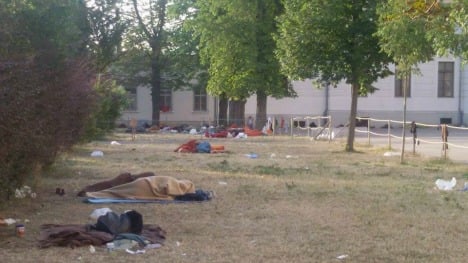They spoke to The Local about their arduous and often terrifying journey, with their eight-year-old son, Saad’s 78-year-old grandmother, his aunt and her four children.
Now safe in the small town of Göllersdorf in Lower Austria, Saad smiles as he gestures towards a pink garden fence and invites me in. “This is our home, sweet home,” he says. After 18 days in the overcrowded and “hellish” refugee reception centre in Traiskirchen, the family are grateful to have been given a place to live by the Diakonie charity, whilst they wait for their asylum claim to be processed.
Saad, a tall and striking 34-year-old, is an actor and stand-up comedian. His wife Oula was an assistant director in Syria, but made a film which was critical of the hijab worn by some Muslim women and was threatened by government officials. Many of their family members had already spoken out against the Syrian regime and had to seek asylum abroad after it became impossible for them to work in Syria.
Their lively son Ram, who also speaks English, just celebrated his ninth birthday and has started school in Austria. “We didn’t want to leave Syria, we wanted to be able to live somewhere where we could both pursue our chosen careers – but that was becoming impossible,” Oula told me.
Their decision to leave their home was sparked by one dreadful night during which more than 120 mortar bombs exploded in their neighbourhood. They lived at the top of an apartment building and it felt increasingly dangerous. “We had no water, no electricity, the city was fading away, dying before our eyes,” Saad said.
After getting in touch with friends who had already fled Syria they got a contact number for a man in Istanbul who could help smuggle them to a port in Turkey, where they planned to take a boat to Greece. They sold everything they had, including their car and clothes, to fund the trip – which ended up costing a total of around €60,000, Saad estimates.
'They see bags of dollars'
“We didn’t want to travel in one of those dinghy boats to Greece – we knew that would be too dangerous. So we spoke to a man who showed us a video of a tourist yacht that he promised we would be smuggled in,” he said. However, they quickly learnt that “all the people smugglers are liars. When they look at us, they don’t see people, they see bags of dollars.”
They travelled through Turkey in the back of small van which had capacity for 13 people but was carrying 25. “There were no windows and hardly any air and we drove on small, winding mountain tracks that were really footpaths – avoiding any checkpoints. The driver was driving so dangerously it was as if he was on drugs,” Saad recalls.
When they arrived at the port in Turkey, the ‘yacht’ turned out to be a large fishing boat, and they were crammed in the hold along with around 100 others. “We couldn’t stand up, we couldn’t move,” Oula recalls. “There was no air and soon everyone was vomiting.”
A Syrian fisherman captained the boat, and Saad believes he is part of a Syrian mafia making money from people who are fleeing the country. The crossing took seven hours, and towards the end it became rough and water started to come below deck.
“Everyone was praying to their various gods. The captain got so scared he ended up calling his brother who called the Greek coastguard – who came and rescued us. They took us to Rhodes. The coastguard told us later that the captain of the boat had actually planned to just dump us on an uninhabited Greek island,” Saad said.
'We decided to walk to Austria'
In Rhodes it took the family four days to organise fake ID’s – easily available from criminal gangs – and get papers which would allow them to stay in Greece for six months. But when they got to Athens and tried to buy a flight to Vienna a policeman recognised that their ID’s were fake. “He basically laughed at us and told us to go back to Syria,” Saad said. “So we decided we would walk to Austria instead.”
Along the way fellow travellers would pass out contacts for people smugglers who were driving people some of the way – for a price – and Saad would buy a SIM card in each country they passed through and contact a smuggler to come and pick them up.
“We were lucky, we had some money, other people didn’t. We met one man who had walked for three days non-stop. His feet were so beaten up that he begged a Red Cross team in Syria to take him to prison so that he could get medical treatment and food”.
Their son, Ram, kept their spirits up. “We had to pretend everything was OK, for his sake, but also he was always the one leading us as we walked, telling us that he wanted to have an adventure,” Oula said.
When they finally reached the Hungarian border, after more than a month after leaving Damascus, it cost a further €150 for each of them to cross the border. “A Serbian man drove us part of the way – then we crossed the border on foot – and he picked us up in Austria, to avoid being caught by the Hungarian police,” Saad recalls.
Saad’s mother (who now lives in Sweden) had called the family to warn them against travelling in the back of transporter vans, which she had heard was dangerous as you risk suffocating. So they always chose the more expensive option – a taxi or small van.
When they arrived on the outskirts of Vienna the driver suddenly stopped and told them to get out. “That was so mean of him. We had no idea where we were and we were exhausted. He even dropped us 20 metres from a police station!” Saad remembers.
After getting their bearings they called Oula’s brother to tell him they had finally arrived and found a taxi to take them to his flat, where they were finally able to shower and rest.

Conditions at Traiskirchen were shocking. Photo: ORF
Once they had registered with the authorities and told them they were seeking asylum they were sent to Traiskirchen reception centre. “We spent our first night there sleeping outside on the ground, it was cold and windy. It didn’t feel like we were safe – there were massive fights going on between different groups of people. We couldn’t use the toilets or showers because they were so filthy – it was almost worse than being in Syria!” Saad said.
After 18 days in Traiskirchen, during which time they purchased a tent to sleep in, they were able to speak to the Diakonie charity who found them a home.
“People here have been so generous and welcoming,” Oula said tearfully. “They have lent us bikes and invited us around to lunch. I’m so grateful and I just hope that we’ll be able to stay and work here and give back to society at some point”.
Read more: The Germans offering their homes to refugees



 Please whitelist us to continue reading.
Please whitelist us to continue reading.